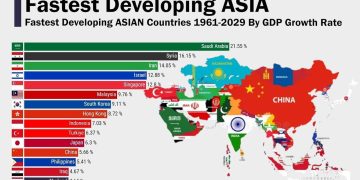Introduction: The Monetary World Enters an Era of Transformation
The international monetary system—long anchored by the U.S. dollar and supported by a unified global financial architecture—is entering a period of historic change. Central bank digital currencies (CBDCs), private stablecoins, blockchain-based settlement layers, and new cross-border payment infrastructures are reshaping how money moves across borders. At the same time, geopolitical fragmentation is accelerating the shift toward a more multipolar currency world, where the dollar retains dominance but faces increasing competition from regional and digital alternatives.
This article examines the forces driving the rise of digital currencies, the geopolitical motivations behind CBDC development, the implications for cross-border payments, and the potential path toward a multi-currency, multi-platform global monetary system. In a world where technology and geopolitics are converging at unprecedented speed, the future of money is being rewritten—not by one country, but by a constellation of actors, each pursuing strategic advantage.
1. The Technological Foundations of Digital Money
1.1 Blockchain and the Reinvention of Trust
At the heart of modern digital currency lies the blockchain—a decentralized ledger technology that creates a unified, tamper-resistant record of transactions. Unlike traditional financial systems, where banks act as intermediaries and settlement can take days, blockchain enables near-instant, transparent, and secure value transfer.
Key technological capabilities include:
- Distributed consensus, eliminating the need for a central clearing entity
- Programmable smart contracts, enabling automation of trade, settlement, and compliance
- Interoperability frameworks, allowing multiple networks to interact
- Cryptographic security, reducing fraud and improving auditability
These innovations form the backbone of CBDCs, stablecoins, and digital settlement networks.
1.2 Tokenization of Money and Assets
Tokenization—the process of representing financial value as digital tokens on a blockchain—extends beyond currency:
- Government bonds
- Corporate equities
- Commodities
- Real estate
- Art and intellectual property
As tokenized assets become more widespread, the lines between currency, collateral, and investment instruments will increasingly blur. Digital currencies are the foundation enabling this new financial ecosystem.
1.3 The Rise of Instant Payment Systems
Even outside blockchain, digital payments are accelerating transformation:
- FedNow in the United States
- PIX in Brazil
- UPI in India
- SEPA Instant in Europe
- Faster Payments in the United Kingdom
These systems demonstrate that instant, digital-native transactions are now expected as a standard feature of modern money.
2. CBDCs: The New National Financial Infrastructure
2.1 Why Central Banks Are Rushing to Issue Digital Currencies
More than 130 countries—representing over 98% of global GDP—are exploring CBDCs. The motivations vary:
- Enhancing monetary sovereignty
- Capturing digital payment data for macroeconomic analysis
- Reducing reliance on private payment rails such as Visa, Mastercard, or SWIFT
- Improving financial inclusion
- Lowering cross-border transaction costs
- Maintaining control as stablecoins grow
Though political and economic priorities differ, the underlying theme is clear: countries want to future-proof their monetary systems.
2.2 China’s Digital Yuan: The Most Advanced Major CBDC
China is the global leader in CBDC implementation. The digital yuan (e-CNY):
- Has been piloted in 260+ million wallets
- Processes billions of RMB in transactions monthly
- Is accepted for public transportation, retail payments, and government services
- Integrates with Hong Kong’s FPS system
- Is being tested for cross-border usage with the UAE, Thailand, and Singapore via mBridge
Strategically, the digital yuan strengthens China’s monetary efficiency, supports yuan internationalization, and offers a sanctions-resistant payment infrastructure.
2.3 Europe and the Digital Euro
Europe’s fragmented banking system and low private-sector innovation have pushed the ECB toward CBDC development:
- A digital euro project is in the “preparation phase”
- Focus areas include privacy-preserving digital payments
- The ECB aims to compete with non-EU tech giants in digital payments
The digital euro is less geopolitically motivated than the digital yuan, but it serves as a catalyst for financial modernization.
2.4 The United States and Its Cautious Approach
The U.S. is moving slower due to:
- Concerns about surveillance
- Political resistance
- A strong existing financial system
- Dominance of private sector innovation
Instead of a retail CBDC, the U.S. is prioritizing:
- Wholesale CBDCs
- Digital dollar frameworks
- Regulated stablecoins
- Public-private hybrid payment infrastructures
This approach reflects American financial dynamics: innovation driven by the private sector, with government oversight rather than direct implementation.
3. The Role of Stablecoins and Private Digital Currencies
3.1 Stablecoins as the Dollar’s Digital Expansion
While CBDCs are government-driven, stablecoins—especially U.S. dollar–backed ones—are market-driven. Today:
- Over 90% of stablecoin value is pegged to the U.S. dollar
- Stablecoins settle more value annually than PayPal
- U.S. stablecoins dominate crypto liquidity and digital commerce
- Emerging markets increasingly use stablecoins as a hedge against domestic inflation
Paradoxically, stablecoins accelerate dollarization, strengthening U.S. monetary power even as de-dollarization narratives grow.
3.2 Corporate Digital Money: The Next Frontier?
Big tech may eventually issue their own digital money:
- Apple Pay and Google Pay already serve as quasi-financial intermediaries
- Amazon could tokenize merchant credits
- Tesla could integrate payments into vehicle networks
- OpenAI-linked or AI-native currencies could emerge
While regulatory scrutiny remains high, the possibility of corporate digital money introduces a new competitor to traditional fiat systems.
3.3 Decentralized Stablecoins and Algorithmic Models
Experiments include:
- Overcollateralized crypto-backed stablecoins (e.g., DAI)
- Algorithmic models (e.g., Terra UST—whose failure shows the risks)
- Hybrid models with decentralized governance and real-world asset collateral
These systems raise questions about stability, regulation, and systemic risk.
4. Cross-Border Payments: The New Battlefront
4.1 The Problem with Today’s Cross-Border Payments
Current global payment rails—dominated by SWIFT, correspondent banking, and Western intermediaries—are:
- Slow (often taking 2–5 days)
- Expensive (up to 7% fees for remittances)
- Fragmented
- Exposed to sanctions and geopolitical pressure
Digital currency networks aim to solve these inefficiencies.
4.2 mBridge: The Most Ambitious Multi-CBDC Project
Led by:
- Hong Kong Monetary Authority
- People’s Bank of China
- Bank of Thailand
- Central Bank of the UAE
mBridge allows trade settlement in multiple CBDCs without relying on the dollar or SWIFT. Its strategic implications are profound:
- Reduces settlement costs for cross-border commerce
- Provides an alternative to dollar-dominated rails
- Increases financial resilience for participating countries
If widely adopted, mBridge could reshape Asian and Middle Eastern trade flows.
4.3 SWIFT’s Digital Pivot
SWIFT is developing:
- Interoperability between CBDCs
- Tokenized asset settlement
- Real-time compliance and identity verification
Rather than being replaced, SWIFT is transforming itself to remain the backbone of global finance.
4.4 Competing Regional Networks
Regional digital payment blocs are forming:
- ASEAN cross-border QR payments
- Africa’s Pan-African Payment and Settlement System
- Latin American regional digital wallets
- Arab digital currency experiments
These systems reduce dependency on global intermediaries and promote monetary sovereignty.
5. Digital Currencies and Geopolitics: The Strategic Dimension
5.1 The U.S. Dollar’s Paradoxical Position
The dollar faces two simultaneous forces:
- Digital transformation strengthens dollar dominance (via stablecoins)
- Geopolitical rivalry accelerates de-dollarization efforts
The result is a world where the dollar remains king, but alternatives are growing faster than ever before.
5.2 China’s Strategy: Building a Parallel Financial System
China’s goals for digital currency infrastructure include:
- Reducing dependence on Western rails
- Enhancing yuan usage in Belt and Road economies
- Promoting RMB trade settlement
- Strengthening national security
- Preparing for long-term currency competition with the U.S.
The digital yuan is one of China’s most strategic tools for reshaping global financial architecture.
5.3 The Middle East: Between Dollar Dominance and Strategic Diversification
Major Gulf states are exploring digital currencies to:
- Strengthen regional financial autonomy
- Facilitate oil trade with Asian partners
- Reduce friction in cross-border settlement
- Hedge against potential geopolitical instability
A multipolar energy-finance landscape is emerging.
5.4 Europe and the Quest for Digital Sovereignty
The EU prioritizes:
- Payment sovereignty
- Reducing reliance on American payment giants
- Strengthening regulatory control
- Building a unified digital financial market
The digital euro is as much a geopolitical tool as an economic one.
6. Toward a Multipolar Monetary System
6.1 A Dollar-Dominated but Not Dollar-Exclusive World
Rather than a sudden collapse of U.S. dominance, the world is moving toward layered monetary pluralism:
- Dollar remains the global reserve anchor
- Yuan grows in regional trade settlement
- Euro stabilizes as a major financial currency
- Digital currencies emerge as neutral settlement layers
- Stablecoins serve as private digital dollars
This is not de-dollarization—it is diversification.
6.2 The Rise of “Technological Currency Blocs”
Countries may cluster around shared payment technologies rather than traditional alliances:
- mBridge bloc
- Dollar stablecoin ecosystem (USDC, USDT)
- EU digital infrastructure bloc
- ASEAN QR payment network
- Emerging African digital payment systems
Money is becoming strategic infrastructure, not just an economic tool.
6.3 The Future: Interoperable Digital Monetary Networks
The most likely outcome is a global system where:
- CBDCs interact across shared protocols
- Stablecoins integrate with banking systems
- Tokenized assets settle in multiple currencies
- Cross-border payments are instant, cheap, and programmable
Interoperability—not domination—will define the monetary future.
7. Challenges, Risks, and Unknowns
7.1 Privacy and Surveillance
CBDCs raise concerns about:
- Government tracking
- Programmable restrictions
- Data concentration
- Civil liberties erosion
Balancing efficiency and privacy is a core challenge.
7.2 Cybersecurity Risks
Digital currencies create new vulnerabilities:
- Nation-state cyberattacks
- Quantum computing threats
- Network outages
- Smart contract failures
Security must evolve alongside innovation.
7.3 Financial Stability Risks
Potential risks include:
- Rapid bank disintermediation
- Digital runs on financial institutions
- Stablecoin collapses
- Volatile cross-border capital flows
Regulators must redesign stability frameworks for a digital-first world.
7.4 Fragmentation and Incompatibility
If nations build incompatible CBDC systems, financial fragmentation could worsen, raising costs and reducing efficiency globally.
Conclusion: The Digital Monetary Revolution Has Already Begun
The rise of digital currencies marks one of the most profound transformations in the history of money. While the global financial system remains anchored by the U.S. dollar, we are entering an era defined by:
- Multipolar monetary networks
- Digital-native settlement layers
- Strategic currency blocs
- Programmable financial infrastructure
- Increasing competition between public and private issuers
The question is not whether digital currencies will reshape international finance, but how fast, and in what form. The future will likely be a hybrid system: part traditional, part digital, part centralized, part decentralized. A complex, layered, multipolar monetary ecosystem—one shaped by technology, geopolitics, and innovation.
The financial world is no longer waiting for change.
The transformation is underway.

































